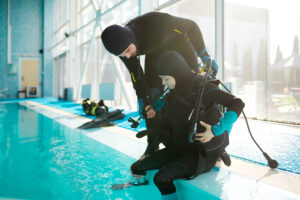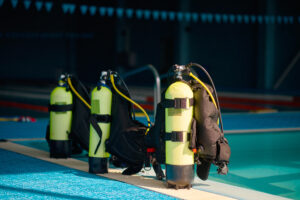What is a Forward Roll Entry?
The forward roll entry, a staple technique for scuba divers, is a safe and efficient way of entering the water from a boat or a pier. As a key skill for divers of all levels, it is essential to master this technique for both safety and comfort. This entry will discuss the benefits of using the forward roll entry, the steps to execute it correctly, and potential hazards and tips to avoid them.
Benefits of the Forward Roll Entry
- Easy execution: The forward roll entry is a relatively simple technique that requires minimal physical effort, making it suitable for divers of varying fitness levels and experience. Its simplicity also reduces the likelihood of injury during the entry process.
- Reduces equipment damage: By entering the water on one’s shoulders and tank, the forward roll entry protects sensitive dive equipment, such as regulators and computers, from direct impact with the water’s surface.
- Minimizes water disturbance: This entry technique generates less water disturbance compared to other methods, such as the giant stride, which can be beneficial when diving in areas with skittish marine life or when maintaining a low profile is necessary.
- Versatility: The forward roll entry can be used from various platforms, including small boats, inflatable boats, and piers, making it a versatile technique suitable for different diving environments.
Steps to Execute a Forward Roll Entry
- Preparation: Before attempting the forward roll entry, ensure that all of your diving equipment is correctly assembled, functional, and secure. This includes checking your regulator, buoyancy compensator device (BCD), and weight system. Additionally, make sure your diving partner is aware of your intention to enter the water.
- Positioning: Approach the edge of the boat or pier while maintaining a firm grip on your mask and regulator. Ensure that you are standing close to the edge without overbalancing. Bend your knees slightly and look down at the water to assess the depth and potential obstacles. It is vital to have a clear area to roll into to avoid collisions with other divers or objects in the water.
- Securing equipment: With one hand, hold your mask firmly in place, covering both the mask’s skirt and the regulator’s mouthpiece. With the other hand, secure your dive computer or any other loose equipment to prevent it from swinging during the roll.
- Execution: Take a deep breath and exhale through your regulator to ensure it is functioning correctly. Then, leaning slightly forward, bend your knees and initiate the forward roll by tucking your head down towards your chest. Allow your body to follow the momentum, rolling into the water and landing on your shoulders and tank. It is crucial to maintain a tight grip on your mask and regulator during the roll to prevent them from dislodging.
- Recovery: Once submerged, immediately establish neutral buoyancy by inflating your BCD, and ensure that your mask and regulator remain in place. Give your dive buddy an “OK” signal to confirm that you have entered the water safely and are ready to begin the dive.
Potential Hazards and Tips to Avoid Them
- Shallow water: Always assess the water depth before attempting the forward roll entry. Rolling into shallow water can lead to injuries or damage to your equipment. If the water is too shallow, consider using a different entry method.
- Surface conditions: Be aware of the water’s surface conditions, such as waves or currents, which can complicate the forward roll entry. In such cases, it may be more suitable to use an alternative entry technique, like the controlled seated entry.
- Obstacles: Ensure that the area you are rolling into is clear of other divers, boats, or debris. Communicate your intention to enter the water with your dive buddy and any nearby divers to prevent collisions. If needed, have someone on the boat or pier assist with monitoring the area to ensure it remains clear during your entry.
- Losing grip on equipment: Maintaining a firm grip on your mask and regulator during the forward roll entry is crucial for preventing them from dislodging. Should your equipment become dislodged, recover your regulator first and clear it by exhaling or using the purge button before replacing your mask. To avoid this situation, practice the entry technique in a controlled environment, like a pool, before attempting it in open water.
- Timing: When diving with a group or a buddy, coordinate your entry to avoid simultaneous forward rolls, which could lead to collisions or confusion in the water. Establish a clear order of entry and ensure that each diver signals “OK” upon entering the water before the next diver proceeds.
- Equipment entanglement: Before entering the water, make sure all your equipment is secured and streamlined. Loose hoses, straps, or accessories can become entangled during the forward roll entry, potentially leading to injuries or equipment damage. Regularly inspect and maintain your gear to prevent such issues.
- Boat movement: When diving from a moving boat, such as a drift dive, be aware of the boat’s position and movement relative to your entry point. Communicate with the boat crew and follow their instructions regarding the timing and direction of your forward roll entry.
Key Takeaways
The forward roll entry is a versatile and efficient technique for scuba divers to enter the water from various platforms, such as boats and piers. By understanding the benefits, following the correct steps, and being aware of potential hazards, divers can safely and confidently execute the forward roll entry. Practicing this technique in controlled environments and regularly maintaining one’s equipment can further enhance safety and comfort during this essential diving skill.

















